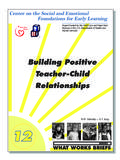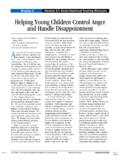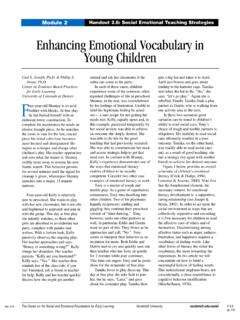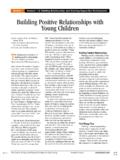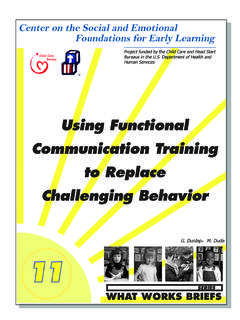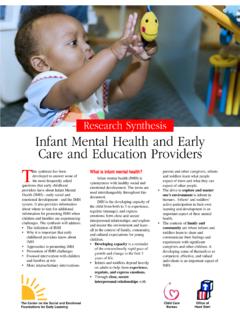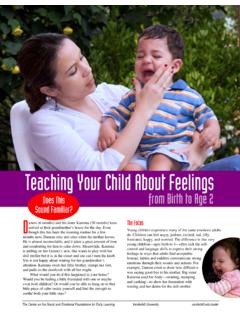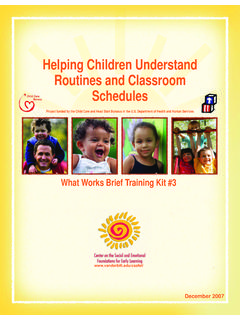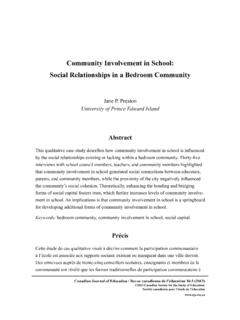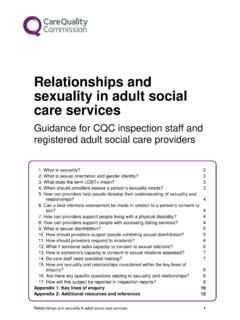Transcription of Expressing Warmth and Affection to Children
1 Center on the social and Emotional Foundations for Early Learning Project funded by the Child Care and Head Start Bureaus in the Department of Health and Human Services Expressing Warmth and Affection to Children S. Twardosz SERIES. WHAT WORKS BRIEFS. Expressing Warmth and Affection to Children This What Works Brief is part of a continuing series of Briefs include examples and vignettes that illustrate short, easy-to-read, how to information packets on how practical strategies might be used in a variety of a variety of evidence-based practices, strategies, and early childhood settings and home environments. The intervention procedures. The Briefs are designed for strategies described in the Briefs are most successful in-service providers and others who conduct staff when used in the context of ongoing positive development activities.
2 Those who are responsible for relationships and supportive environments. The professional development should find them useful in strategies are most successful for an individual child sharing information with professionals and parents to when developed based on observation and help teachers and other caregivers support young assessment of the child including information from the Children 's social and emotional development. The family, teacher, and other caregivers. W hile eating breakfast with her 3- and 4-year-olds, Mrs. Foster's glance falls on Marcus who has been absent for several days. When he briefly looks up from his plate, she smiles and says, I'm happy to see you this morning, Marcus. We missed you.. Mr. Cavendish is reading to three toddlers in the book area. Catherine leans against his shoulder and strokes his hair while peering at the book.
3 Julio and Carl are snuggled at his sides. He reads in an animated tone, occasionally asking or answer- ing questions in a gentle, soothing tone of voice. Amanda needs a diaper change, but she is engrossed with a ball. Mr. Hareem approaches and gently strokes her head while saying, Hey, Amanda, my girl, I need to change your diaper. As Amanda looks up at him, Mr. Hareem smiles, takes the ball, gently picks her up, and begins to sing. Ms. Morton is coping with a rainy day by organizing a strenuous activity for her 4- and-5-year-olds under the covered outdoor area. She and her assistant, Mrs. Kim, cheer, clap, laugh, and shout out encouragement as groups of Children move across the area by first walking backwards, then running, hopping, and jumping. Soon, the Children who have finished first begin to do the same for their peers.
4 What Are Warmth and Affection ? Warmth and Affection are aspects of positive teacher-child laughter, and voice tone; words of endearment ( , little one, . relationships that are critical for Children 's well-being in early I missed you ), encouragement, and playful teasing; and a wide education settings (see What Works Brief #12: Building Positive range of physical contact such as a brief tickle, leaning against, a Teacher-Child Relationships). Expressions of Warmth and quick pat on the head, or a special handshake. Smiling is a Affection occur as teachers and other caregivers protect, guide, particularly effective way of conveying positive emotion from communicate, teach, and play with Children . They help set the earliest infancy and may help Children appreciate other forms of tone for all of these interactions, can reassure and comfort Children , and may help them to relax.
5 Teachers who are warm Teachers' styles of Expressing Affection are and affectionate show Children that they like them, enjoy being certainly influenced by their backgrounds, beliefs, with them, are having fun with them, and are pleased with their and feelings, but classroom organization and the efforts and accomplishments. Expressions of Warmth and relationships teachers have with one another help Affection are most effective in the context of an ongoing positive determine whether or not they actually will express relationship between a child and a caregiver; they also contrib- Affection to the Children . ute to making that relationship positive and authentic. teacher Affection . When interacting with older preschool Sometimes people think about Affection primarily in terms of Children , teachers typically smile and use affectionate words holding, hugging, or stroking.
6 While touch is a very important more than touch. The fact that there are so many different ways means of communicating positive feelings to Children , Warmth of Expressing Affection means that teachers can adjust their and Affection also can be conveyed through facial expressions, styles to the needs, preferences, family and cultural background, August 2005. temperament, and disabilities of each child, as well as communi- More Tips for Teachers cating Warmth in ways that are comfortable for them. Expressing Warmth and Affection to Children in group care requires sensitivity and thoughtfulness. Below are some addi- Setting the Stage for Expressing Warmth and tional points to consider when addressing this issue: Affection Teachers' styles of Expressing Affection are certainly influenced 9 Be sensitive to Children 's reactions to your Warmth and by their backgrounds, beliefs, and feelings, but classroom Affection .
7 Some Children may prefer brief rather than organization and the relationships teachers have with one lengthy physical contact; may have a disability or history another help determine whether or not they actually will express of abuse that influences their reactions to touch, facial Affection to the Children . Warmth and Affection do not occur in a expressions, or voice tone; or may come from a cultural vacuum; they occur in the context of daily routines, activities, background that guides emotional expressiveness in ways and interactions. If these are organized to promote Children 's that may be unfamiliar to you. When in doubt, communi- appropriate engagement with their surroundings, teachers will be cate with parents about such issues. more likely to interact warmly; if they are not, teachers may spend much of their time responding to Children 's inappropriate 9 Accept the fact that you will not feel as affectionate toward behavior with directions, reprimands, threats, and yelling.
8 As a some Children as you do toward others. You will probably result, there will be very few opportunities for the type of be able to express Warmth in some way to each of them relaxed interaction that sets the stage for the expression of because there are so many ways of doing so. It is impor- Affection (see What Works Brief #3: Helping Children Under- tant to remember that Children who are the most challeng- stand Routines and Classroom Schedules, and What Works Brief ing are often those who need Warmth and Affection the #4: Helping Children Make Transitions between Activities). most. Accept the fact that you will not feel as affectionate 9 Think about whether your positive feelings and dedication toward some Children as you do toward others. to teaching are being communicated effectively to chil- You will probably be able to express Warmth in dren.
9 If you are a reserved person, you may want to experiment with being a little more expressive and watch some way to each of them because there are so the effect on the Children . For example, you could choose many ways of doing so. a book that describes people being warm and affectionate and then act out the parts with the Children . In the examples provided at the beginning of this Brief, teachers'. expressions of Warmth and Affection and Children 's responses 9 Avoid being overly warm and affectionate while providing occur within activities, such as a meal, reading, or an outdoor guidance and discipline after a child has been disruptive or game. These are organized to give teachers a chance to respond aggressive. You do not want to encourage Children to to individual Children in a personal way. Mrs. Foster, for misbehave in order to experience individualized, warm example, is sitting at the table eating breakfast rather than attention.
10 Serving plates and moving around wiping up spills, making it more likely that she will think about warmly welcoming Marcus 9 Recognize that frequent expressions of negative emotion back to class. Mr. Cavendish is in the book area where he and toward Children make it more difficult to feel and express the toddlers need only reach out for another book to prolong the Warmth and Affection . Avoid criticism, nagging, yelling, affectionate Warmth of this storybook reading session. If his and reprimands as much as possible, and try to be tolerant colleague is taking responsibility for the other Children in the of Children 's spontaneity. If the overwhelming majority of classroom, then he will not need to break away from the the comments you make to Children are positive, you will affectionate physical contact before the Children are ready.
